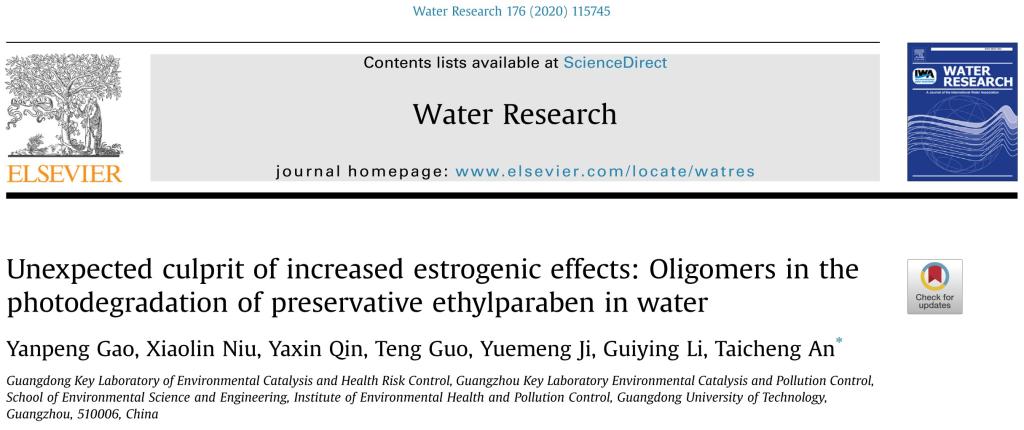近日,广东工业大学环境健康与污染控制研究院,环境科学与工程学院安太成教授和高艳蓬副教授等在典型防腐剂光降解过程中的环境健康研究方面取得新进展,研究成果以《Unexpected culprit of increased estrogenic effects: Oligomers in the photodegradation of preservative ethylparaben in water》为题发表在Water Research, 176(2020):115745杂志上。该研究成果提供了羟基加合物雌激素活性的新认识,改变了传统观念(即认为羟基加合物的雌激素活性高于原型化合物)。同时也为阐明防腐剂对羟基苯甲酸酯光降解与光催化过程中不同的雌激素效应变化提供了有力证据。

近年来,新兴有机污染物转化过程中毒性增强的环境问题倍受关注。本文以防腐剂对羟基苯甲酸乙酯(EP)为模型化合物,探讨其在UV光降解过程中雌激素效应增加的本质原因。结果表明EP降解过程中出现了雌激素活性先增加后降低的趋势,尤其在光照时间为40 min时达到最高。通过对毒性增强过程中的产物进行分析鉴定发现,EP羟基加合物不是雌激素效应增加的原因,因为其EC50值比原型化合物EP高出1个数量级,这一发现提供了关于羟基加合物雌激素活性的新见解,改变了传统的认识。而该过程中雌激素效应增加的真正元凶是光生低聚物产物导致的。我们进一步采用闪光光解实验、产物分析鉴定、以及量子化学计算等手段阐明了毒性产物的形成机理。因此,我们呼吁水体中新兴有机物及其降解产物的环境健康效应亟需引起重视。
论文网址: https://doi.org/10.1016/j.watres.2020.115745
论文的英文摘要附如下:
ABSTRACT:
Widespread occurrence of emerging organic contaminants (EOCs) in water have been explicitly associated with adverse effects on human health, therefore representing a major risk to public health. Especially the increased toxicity is frequently observed during the photodegradation of EOCs in natural water, and even wastewater treatment plants. However, the culprit of increased toxicity and formation mechanism has yet to be recognized regarding the estrogenic activity. In this study, by combining laboratory experiments with quantum chemical calculations, the induction of human estrogenic activity was investigated using the yeast two-hybrid reporter assay during the photodegradation of preservatives ethylparaben (EP), along with identification of toxic products and formation mechanisms. Results showed that the increase in estrogenic effect was induced by photochemically generated oligomers, rather than the expected OH-adduct. The maximum estrogenic activity corresponded to the major formation of oligomers, while OH-adducts were less than 12%. Two photochemically generated oligomers were found to contribute to estrogenic activity, produced from the cleavage of excited triplet state molecules and subsequent radical-radical reactions. Computational toxicology results showed that the increased estrogenic activity was attributed to oligomer [4-Hydroxy-isophthalic acid 1-ethyl ester 3-(4-hydroxy-phenyl)] and its EC50 was lower than that of the parent EP. In contrast, OH-adducts exhibited higher EC50 values than the parent EP, while still possessing estrogenic activity. Therefore, more attention should be paid to these photodegradation products of EOCs, including OH-adducts.